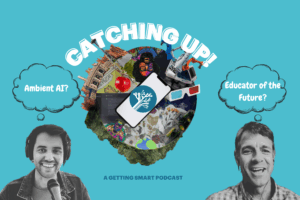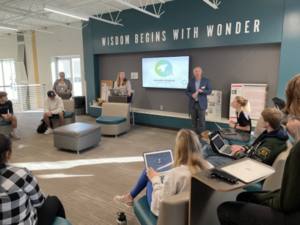A Blueprint for Entrepreneurial Nonprofits Operating Inside Higher Education
Key Points
-
The integration of entrepreneurial nonprofits into higher education institutions like ASU offers numerous benefits, including improved financial sustainability and the ability to leverage the institution’s reputation and resources.
-
Addressing challenges such as financial forecasting and HR flexibility through strategic frameworks can enhance the sustainability and impact of these integrated models.

By: Tami Hill-Washington and Brent Maddin
Across the country, educational nonprofits are seeking new paths toward long-term sustainability. At the same time, institutions of higher education (IHEs) are grappling with how to remain relevant, innovative, and sustainable. Arizona State University, known for its innovative spirit, has created a new structure within the Mary Lou Fulton College for Teaching and Learning Innovation that allows a set of centers, initiatives, and other groups to enjoy the benefits of being part of a large university while also retaining a high degree of agency, autonomy and entrepreneurial agility.
Several initiatives that are part of the newly launched Institute for Learning Design and Discovery are helping to redefine what is possible when embedded within a major university. In practice, these initiatives are operating as independent, entrepreneurial nonprofits under the umbrella of the Institute, each responsible for earning sufficient revenue to cover their independent operating expenses.
The need for the Institute was not immediately obvious. Over the last several years, we have discovered that, in order for the organizations to operate as entrepreneurial nonprofits inside an IHE, we needed a different set of systems and structures, which the Institute is helping to provide.
Two Paths to the Institute
Currently, the Institute for Learning Design and Discovery integrates the work of several initiatives. Each initiative has a unique backstory to joining the Institute, but generally, there were two major pathways: starting within the university and merging as an outside nonprofit.
The Next Education Workforce initiative
Founded in 2017 as part of ASU’s Mary Lou Fulton College (MLFC), the Next Education Workforce initiative partners with school systems to develop strategic school staffing models that produce better learning outcomes for students and better professional experiences for educators. Although the work focused in Arizona originally, partnerships soon included 150 schools in 17 states and the Netherlands. With a five million dollar operating budget and 25 employees, Next Education Workforce was operating more like an entrepreneurial non-profit than a typical university-based center.
The Center for Whole-Child Education
The Center for Whole-child Education (CWCE) originated as the independent nonprofit Turnaround for Children in 2002. CWCE empowers educators with insights and practices grounded in the science of learning so they can redesign how schools and education systems can foster students’ cognitive, social, emotional and physical development. With over two decades of experience translating the science of learning and development into practical tools, Turnaround had reached a crossroads. The COVID-19 heightened existing concerns about how to ensure Turnaround’s long-term sustainability and expand its impact. In order to achieve both greater impact and greater stability, Turnaround merged with MLFC in 2023, joining forces with a like-minded institution and finding a new home that would not only preserve its mission but amplify it.
Key Benefits of Operating Within an IHE
Whether formally integrating into an institution of higher education (like Center for Whole-Child Education) or starting there from inception (like Next Education Workforce), there are tremendous benefits to being part of an IHE.
- Payroll, benefits, and cashflow: As leaders of previous non-profits, we can’t overstate how nice it is to have mission-critical systems that “just work” and about which we think very little. Our employees are paid on time, enjoy excellent benefits (negotiated by someone other than us!), and cash flow is not a problem. Previously, we were worried about the timing of grants, contract invoicing, and reserve balances to ensure that we always had ample cash-on-hand for payroll and other expenses. Of course, we still monitor all of this, but because our budgets are part of the larger institution’s budget, we spend less energy here.
- Credentialing power: One of the key competitive advantages of being part of an IHE is the ability to credential professional learning. The credentials take many different forms (e.g., certificates of completion, micro-credentials, specializations, certifications, and transcriptable credits), and each requires different levels of approval and collaboration with faculty, the larger college, and sometimes the university. While engaging in professional learning with our organizations is great, earning a credential from ASU as part of that is even better, especially if it can articulate into a larger learning path (e.g., a degree program).
- Reputational “halo effect”: Some of the halo effect that we enjoy comes from being a part of ASU, and specifically ASU’s 10-year run of being named #1 in innovation by U.S. News & World Report. But some of it comes from being part of a respected institution of higher education, generally. Saying that we are part of an IHE grants us different entry into conversations with school systems, state departments, and vendors. Additionally, having multiple organizations under the umbrella of the Institute allows us to engage with school systems as “one ASU” with many areas of expertise. Instead of multiple contracts with several organizations we can offer a set of coherent solutions under one.
These are just three of the most salient benefits of operating within an IHE. There are dozens of others (e.g., proximity to research faculty, ability to collaborate with other colleges, incredible technology support). Of course, there are challenges too, but thinking through them together has helped us navigate them more effectively.
Navigating the Challenges of Working Within a System Built for a Different Model
Both the Center for Whole Child Education and the Next Education Workforce initiative have encountered existing systems and structures within ASU that do a great job of supporting the institution’s primary purposes–educating students in degree programs and producing world-class research—but not necessarily advancing entrepreneurial nonprofits. Similar to the hidden systems that make new innovative models challenging in K-12 schools, the systems and structures at IHEs were not designed to support centers operating as entrepreneurial nonprofits.
In a collaborative effort with institutional leadership to address these challenges, we developed an infrastructure assessment that identified challenges both of our organizations were facing and that might be shared by others across university-based centers (both at ASU and beyond). These challenges fell into six major categories:
- General Operations
- Grants & Contracts
- Financial Management
- Marketing & Communications
- Technology & Software
- Event Planning & Execution
To diagnose the root causes, we assessed whether challenges were primarily platform/product/policy challenges (structural/system-based), people/capacity challenges (staffing/expertise gaps), or mindset challenges (cultural/institutional norms). We also rated these challenges on two dimensions: the level of existential risk in which the challenge placed the organization and the relative ease of resolving the challenge.
Using this framework, we plotted each challenge in a 2×2 matrix. As shown in Figure 1, the x-axis represents the level of existential risk to our organizations–the further to the right, the more likely that not addressing the challenge could lead our organization to fail. The y-axis represents how easy it would be to resolve the challenge–the higher on the y-axis, the more difficult the resolution would likely be.
Given the relative levels of risk and ease of resolution, particular quadrants represent different actions that can be taken by both the organizations and the Institute. For example, it makes sense to prioritize the challenges in the bottom right because they present higher risk but likely have easier resolution.
| Lower risk, harder resolution<Deprioritize action here> | Larger risk, harder resolution<Invest here> |
| Lower risk, easier resolution <Enjoy quick wins here> | Larger risk, easier resolution <Prioritize action here> |
By categorizing each of the challenges using this framework, as shown in Figure 2, we were able to decide more strategically which challenges to tackle. An example from each quadrant can help demonstrate what may be required to solve challenges in each. For example:
- Financial Forecasting (top right): Financial reporting systems within the larger university have been designed historically to provide insight during the current fiscal year. However, given the charge to be financially sustainable, we need the ability to forecast multiple years in the future. Not being able to do so presents huge risks to our organizations (e.g., solvency, appropriate staffing) and arriving at a solution will mean coordinating across multiple systems, therefore “larger risk, harder resolution.”
- Title/Comp Flexibility (bottom right): Titles and salary bands exist in the university-based HR system, however these can sometimes be out-of-synch with non-profit, industry standards. We have lost candidates because we couldn’t make competitive offers, had titles that felt like a demotion, or couldn’t navigate the university-based system fast enough. With ASU’s recent transition to a new HR platform, we believe there may be new flexibilities, therefore “larger risk, easier resolution”.
- Business Rules: Revenue (bottom left): Each of our organizations earns revenue in myriad ways (e.g., consulting, cohorted professional learning, site visits, instrument licenses, federal grants, private gifts). At ASU, revenue incurs different fees depending on the source, but those fees are not always well known, and the source is not always clear. The difference between 5% and 11% matters, but knowing the rules (now that we know there are differences) and classifying revenue sources is not that complex–”lower risk, easier resolution.”
- Scoping Shared Services Supports (top left): One of the benefits of being part of the university are the shared service supports (e.g., finance, marketing, technology). However, as our organizations have grown in size and complexity, our needs in these areas have scaled commensurately, often outstripping what can be provided by shared services teams, given the primary work of the college. We need to know how much shared service we can each expect (e.g., how many hours a month of a web developer’s time should we count on), but this can be difficult to estimate given often evolving needs from multiple parties and recent cuts to university budgets, generally. Given the uncertainty, we have hired employees or contractors that can cover more mission-critical shared services as needed, ultimately making this problem “lower risk, harder resolution.”

Recommendations Based on Lessons Learned
Now, several years into operating as entrepreneurial nonprofits inside of an institution of higher education, we have several recommendations based on lessons learned and challenges still to be solved. These recommendations apply to both organizations scaling within IHEs as well as those who have joined IHEs or may be contemplating mergers. Here are just a few recommendations.
For entrepreneurial nonprofits:
- Lean into the unique value proposition of IHEs: Be clear-eyed and enthusiastic about the advantages of associating with an IHE. These will vary by organization and IHE, but all should relate to shared goals with the institution that preserve and elevate your mission. Come back to these reasons often, especially when challenges arise.
- Infrastructure assessment: Conduct an infrastructure assessment, similar to what we’ve described above, to understand the needs of your operating model before scaling or merging.It will elucidate where potential misalignment may exist with existing systems and clarify where support, work, and/or compromise may be needed.
- Seek alignment where possible: Proactively align fundraising, content, and operations with university processes, prioritize clear communication around goals, and all-the-while advocate for agility and innovation.
For Institutions of Higher Education:
- Power of an “institute”: We have seen the benefit of having some sort of meta-structure with which entrepreneurial organizations can be organized. IHEs thrive when there are standard operating procedures, and we’ve seen how our Institute has created space and advocates for a new way of operating that would be difficult for any of our organizations to do alone.
- Identify an operations liaison: Even without developing a formal, institute-like structure, IHEs can identify a single-point of contact to work with organizations as they encounter challenges and have needs that are not aligned with business-as-usual. They should know how to navigate existing systems and love finding third-way solutions.
- Learn from the organizations: Create formal and informal ways to learn with and from the entrepreneurial nonprofits. Given their need to operate sustainably, they are much more attuned to what the larger market wants and needs that IHEs have not, historically, been servicing. Learning from them increases the likelihood that the IHE will remain relevant and connected.
Looking Ahead: A Call to Action
Our experience operating as revenue-generating centers within a university has offered valuable insights, not only into what works but also into what must improve to drive greater impact and long-term sustainability. The challenges we’ve encountered—navigating institutional systems, aligning processes, and sharing innovations—are common across many centers within higher education regardless of where and how they started.
Through collaboration, rethinking established structures, and seeking out efficiencies, the Center for Whole Child Education and the Next Education Workforce initiative are helping shape a new model—one where nonprofits and universities don’t just coexist, but are integrated and actively strengthen one another. The creation of the Institute for Learning Design and Discovery, at MLFC enabled an organizing structure that can bring coherence across initiatives and work to actively solve the challenges that arise naturally when entrepreneurial organizations sit inside institutions of higher education.
Tami Hill-Washington is the Executive Director at the Center for Whole-Child Education
Brent Maddin is theExecutive Director at the Next Education Workforce initiative





0 Comments
Leave a Comment
Your email address will not be published. All fields are required.